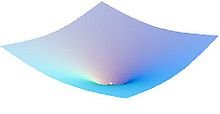Schwarzschild black hole
A Schwarzschild black hole or static black hole is one that is defined by a single parameter, the mass M, more specifically the Schwarzschild black hole is a region of space-time that is bounded by an imaginary surface called the event horizon. This border describes a space from which not even light can escape, hence the name black hole. Said space forms a perfect sphere in whose center is the singularity; its radius is called the Schwarzschild radius. The formula of said radius, as has been said, depends only on the mass of the hole:
rs=2GMc2,{displaystyle r_{s}={2GM over c^{2}}},}
Where G is the gravitational constant, M is the mass of the hole, and c is the speed of light. The greater the mass of the black hole, which determines the degree of space-time curvature, the greater the Schwarzschild radius. The geometry of space-time around a Schwarschild hole is given by the Schwarzschild metric:
g=− − c2(1− − 2GMc2r)dt dt+(1− − 2GMc2r)− − 1dr dr+r2(dθ θ dθ θ +without2 θ θ dφ φ dφ φ ){displaystyle g=-c^{2}left(1-{frac {2GM}{c^{2}r}right)mathrm {d} totimes mathrm {d}{d} t+left(1-{frac}{2GM}{c^{2}{2}{dmmat}
This was one of the first exact solutions of Einstein's field equations of general relativity due to German physicist Karl Schwarzschild. Furthermore the peculiarities of the metric for r < 2GM/c2 gave rise to the concept of the black hole itself.
Phenomenological description
The theory of relativity predicts that, inside a Schwarzschild black hole, a theoretical boundary hypersurface will appear, such that as we approach it the curvature tensor grows and grows without limit. This type of geometric object is known as a space-time singularity, and can be understood as a limit beyond which space-time cannot be modeled within the theory (it is assumed that near the singularity quantum effects are important).
Furthermore, the space-time inside the Schwarzschild hole region is geodesically incomplete for any time geodesic inside the hole, which means that a particle free falling inside the hole after a finite time will inevitably reach singularity. We currently have no theory that tells us exactly what happens when a particle reaches the singularity.
In the case of Schwarzschild this singularity is of temporary type, if it turned out that the fact of arriving at a sufficiently small distance from the singularity would suppose the destruction of the particle itself, as is sometimes supposed, then the particles that move at higher speeds inside the hole they would disappear "volatized" later and the slowest before. That fact fits with the temporal character of the singularity, as opposed to a spatial singularity that can be understood more as a locus.
Other types of black holes
However, there are other more complicated models of black holes:
- Kerr's black hole is a black rotation hole defined not only by its mass but also by its angular moment. This hole has a privileged direction in space and therefore ceases to be isotrope. This is the model that best fits the type of black holes that can be seen from the collapse of supermassive stars.
- The black hole of Reissner-Nordström is a hole with electric and static load, which has special properties since not only a gravitational singularity is formed but also a singularity in the electric field generated by the hole. This hole is also subject to two parameters: mass and load. The existence of such holes has not been observed but the possibility of creating them in controlled conditions such as particle accelerators could be conceived.
- Finally is the black hole of Kerr-Newman. This third type of holes are the result of the combination of the previous two. It would be the black holes with load and rotation. These holes would depend on the three parameters: mass, angular moment and load. In addition, the rotation would cause a movement of loads in its bosom that would lead to the generation also of a magnetic field.
Contenido relacionado
Ice
Weight
Electron cloud


